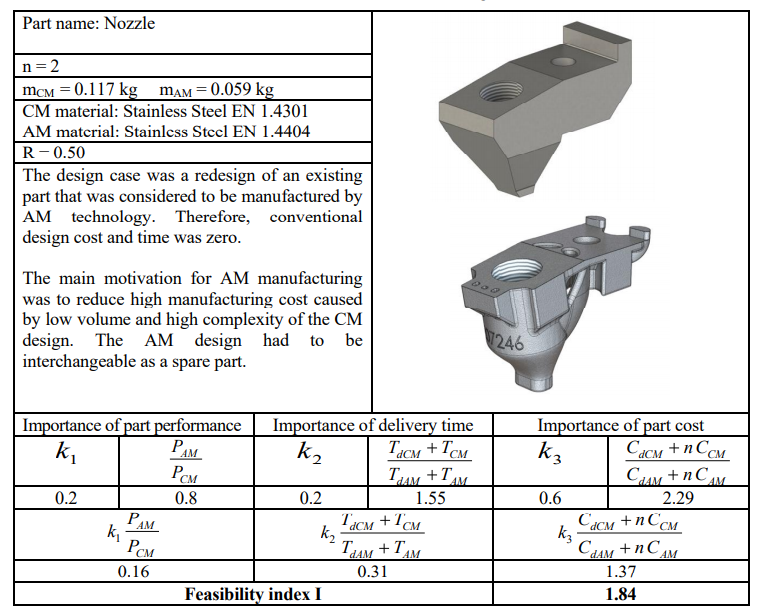Feasibility Models to Determine Efficacy of 3D Printing Over Traditional Methods
In ‘Model for Evaluating Additive Manufacturing Feasibility in End-Use Production,’ authors Matt Ahtiluoto, Asko Uolevi Ellman, and Eric Coatenea encourage the idea of exploring 3D printing for designs first, comparing them to industrial tasks performed with conventional methods. For production today, the authors explain that designers should begin considering AM processes more often, especially for low-batch volume parts.
While the researchers understand that affordability can still be an issue on the larger production scale, the accessibility is there—what may not be available is an understanding by designers, or exposure. They also may not understand how to design, print, and finish products afterward, requiring some level of education on the process should they deem a part feasible for AM. Items to consider are whether they are attempting to fabricate special parts or those that may be impossible to print otherwise (such as complex lattice structures), if there would be better results with complex geometries, as well as comparisons for production times. Affordability is, of course, a factor too. In some cases, complex parts may be much cheaper to fabricate.
Every case is different, and decisions may not be predicated on the performance of the part either as there may be more important factors in play such as speed in production or affordability. Using the feasibility model created for this research, the authors noted that in the majority of the cases analyzed here, AM was the better choice.
Much of the feasibility is dependent on part performance though, to include details such as:
- Weight
- Ease of use
- Flow resistance
- Aesthetics
- Part consolidation
- Reduced assembly time
- Prediction of functionality
“For reliable results, part performance evaluation must be done consistently. Part production volume affects to design cost so that on small volumes AM redesign cost may not be justifiable if CM design exists. If neither design yet exists, AM design cost may sometimes be smaller due to lack of manufacturing constraints and lack of need for manufacturing drawings.”
For this research, more optional approaches were not part of the equation, as the authors stuck solely to performance, cost, and time; it is important to remember, however, that different factors may be used, thus requiring a ‘recalibration’ of the index interpretation. The index is also, at best, an approximation concerning which technique would be best in comparing AM with conventional.
“Despite main application of the model being in justification of AM in business environment and industrial use, the tool may provide to be an educational tool as well,” concluded the researchers. “AM is just another manufacturing method among many others and only specific parts are profitable to manufacture with AM. This feasibility model aims to provide a practical tool to understand AM applicability better.
“This method is also customizable for specific needs by modifying estimated part properties: performance, delivery time and cost. If part feasibility is evaluated early in the design process, ideally AM method can be selected before CM design is launched and designers are able to produce technically better solutions, faster and at lower cost.”
3D printing and additive manufacturing techniques are compared to traditional methods of manufacturing often these days, from combining different methods to making comparisons in 3D printing, and exhibiting artwork. What do you think of this news? Let us know your thoughts! Join the discussion of this and other 3D printing topics at 3DPrintBoard.com.
[Source / Images: ‘Models for Evaluating Additive Manufacturing Feasibility in End-Use Production’]Subscribe to Our Email Newsletter
Stay up-to-date on all the latest news from the 3D printing industry and receive information and offers from third party vendors.
Print Services
You May Also Like
3D Printing Grows to $15.9B in 2024 Amid Shifting Industry Dynamics
The global additive manufacturing (AM) market reached $15.9 billion in calendar year 2024, according to “Q4 2024 3DP/AM Market Data and Forecast” from Additive Manufacturing Research (AM Research). Despite a...
3DPOD 247: LJ Holmes, Executive Director for the Center of Advanced Manufacturing and Materials at Harrisburg University
Executive Director for the Center of Advanced Manufacturing and Materials at Harrisburg University, Larry “LJ” Holmes is a pioneer in applying additive manufacturing to defense and other critical sectors. Part...
Thai Startup OsseoLabs to Cut Surgery Time with 3D Printed Magnesium Implants
A patient undergoing mandibular reconstructive surgery typically faces two separate operations: one to place a custom-fit titanium plate and another month later to remove it. But what if that second...
Japanese Advanced Manufacturing Capabilities Grow in Europe with Sodick’s Purchase of Prima Additive
The global economy is currently undergoing a reshuffling in terms of what gets manufactured where. In large part, this trend is being driven by new geopolitical alliances and the need...




























